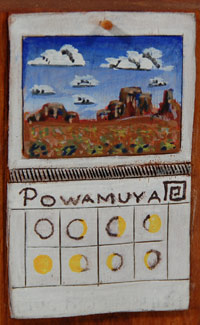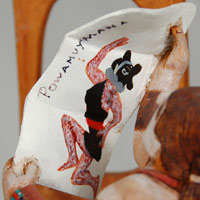Hopi-Tewa Koshari Clown Seated Viewing Picture of Kokopellmana Katsina [SOLD]
+ Add to my watchlist Forward to Friend
- Category: Traditional
- Origin: Hopi Pueblo, Hopituh Shi-nu-mu
- Medium: cottonwood, paint
- Size: 9” max height; 7-1/4” x 5-3/4” pedestal
- Item # C3383G SOLD

Brian Honyouti is a celebrated master Katsina doll carver who was born in 1947 in the village of Hotevilla on Third Mesa. His story is one of courage, characterized by his ability to overcome life's challenges. He attended the Tucson School for the Blind and the Deaf. While in school, he distinguished himself as an exceptional athlete. From 1962 to 1965, he won the State Championship four years in a row and was honored in the Wrestling Hall of Fame.
Brian started carving Katsina dolls in the mid-1960s. He learned his carving techniques from his father, who taught him how to make one-piece carvings. He began using oil paints in 1978, and he is universally credited with being the first carver to use wood preservatives and varnish as a sealer, instead of the usual white undercoat, leaving the flesh areas unpainted and revealing the natural wood colors. He rarely uses Dremel tools and wood burners, preferring to do all of his carving with pocket knives, chisels, hack-saw blades and small files.
Brian, and his brothers, Ronald and Lauren, and their dad, Clyde, have set the standard for others to follow. They all carve one-piece dolls and do so in an extraordinary fashion.

This carving is more than just a katsina doll; it is a panorama presenting a story. The clown is seated, cap off and resting on the floor, while looking at a "calendar girl" poster of Kokopellmana Katsina, the female companion to the Kokopelli Katsina—the two representing fertility. A cabinet with faux mirror has a calendar tacked to the back showing dates of the upcoming Powamuya Ceremony. A frog-like ashtray and coffee cup rest on a side table. A book entitled Chaos sits under the bench on which the clown reposes.
Basically, each individual piece of the panorama is a one-piece carving, the individual items themn assembled to form the whole.
Condition: original condition
Provenance: from the estate of Tom Mittler, a former resident of Michigan and Santa Fe
Recommended Reading: Hopi Katsina: 1,600 Artist Biographies by Gregory Schaaf
- Category: Traditional
- Origin: Hopi Pueblo, Hopituh Shi-nu-mu
- Medium: cottonwood, paint
- Size: 9” max height; 7-1/4” x 5-3/4” pedestal
- Item # C3383G SOLD



